Strategic Leadership Practices Report: Leadership and Management
VerifiedAdded on 2020/02/03
|13
|4277
|51
Report
AI Summary
This report delves into strategic leadership practices, examining the roles of managers and leaders within an organization, using ABC Company and CAPCO as case studies. It explores the differences between management and leadership, highlighting the importance of both in achieving organizational goals. The report analyzes various leadership styles, such as democratic and autocratic approaches, and their impact on strategy implementation, vision, mission, and values communication. It also discusses the importance of commitment, self-belief, and personal energy in effective leadership, referencing Wideman's and Farey's models to illustrate the balance between management and leadership. The report concludes by emphasizing the need for leaders to foster knowledge, process, team, and succession development within their organizations.
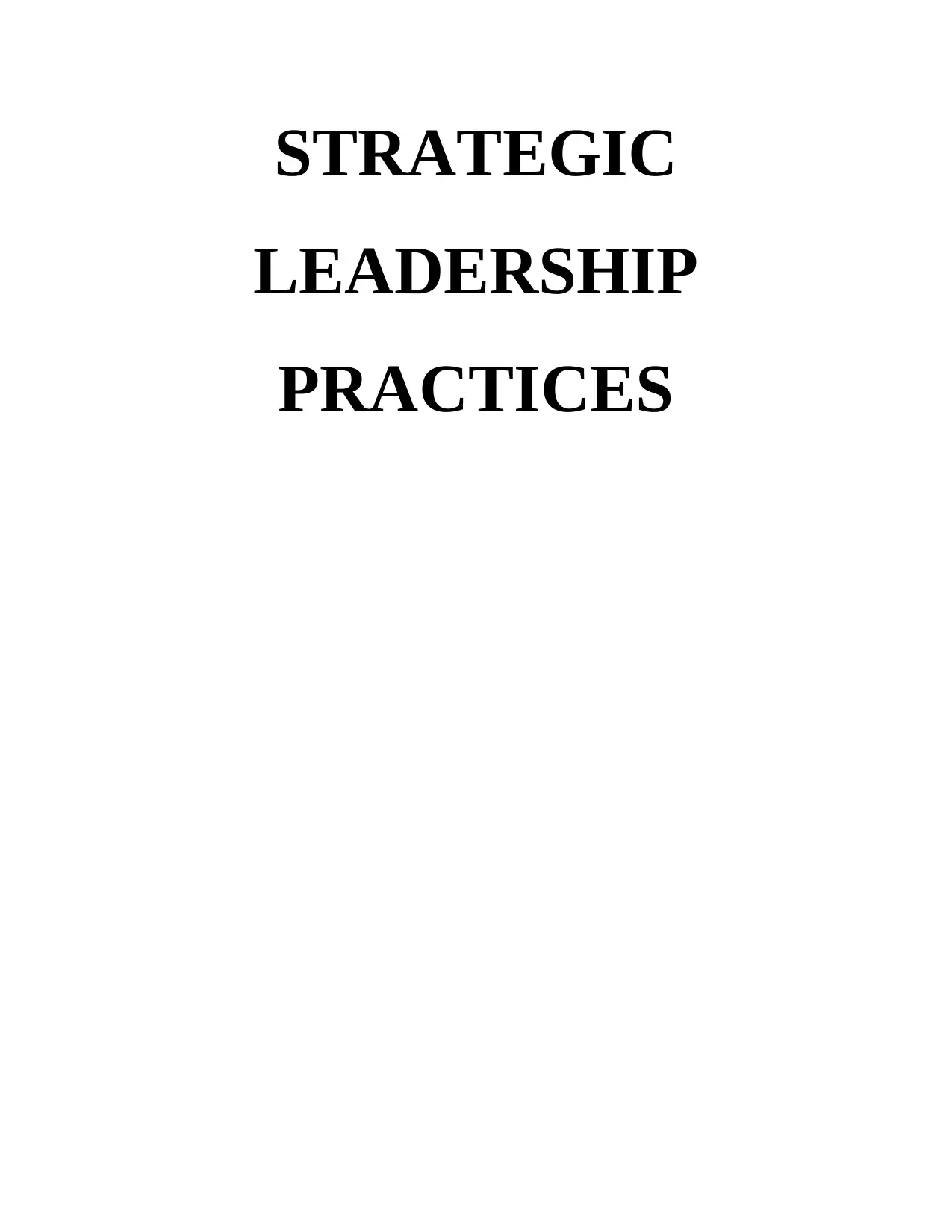
STRATEGIC
LEADERSHIP
PRACTICES
LEADERSHIP
PRACTICES
Paraphrase This Document
Need a fresh take? Get an instant paraphrase of this document with our AI Paraphraser
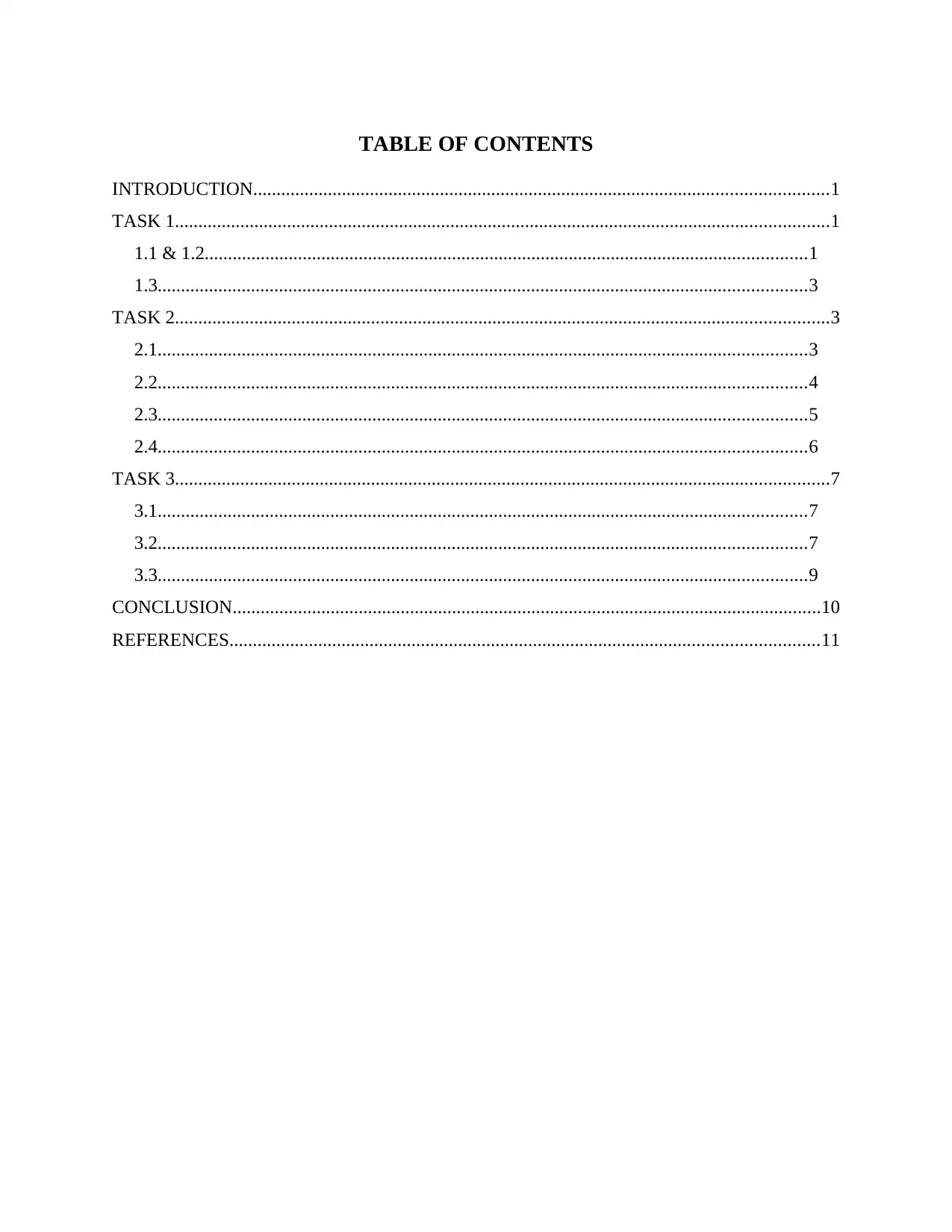
TABLE OF CONTENTS
INTRODUCTION...........................................................................................................................1
TASK 1............................................................................................................................................1
1.1 & 1.2.................................................................................................................................1
1.3...........................................................................................................................................3
TASK 2............................................................................................................................................3
2.1...........................................................................................................................................3
2.2...........................................................................................................................................4
2.3...........................................................................................................................................5
2.4...........................................................................................................................................6
TASK 3............................................................................................................................................7
3.1...........................................................................................................................................7
3.2...........................................................................................................................................7
3.3...........................................................................................................................................9
CONCLUSION..............................................................................................................................10
REFERENCES..............................................................................................................................11
INTRODUCTION...........................................................................................................................1
TASK 1............................................................................................................................................1
1.1 & 1.2.................................................................................................................................1
1.3...........................................................................................................................................3
TASK 2............................................................................................................................................3
2.1...........................................................................................................................................3
2.2...........................................................................................................................................4
2.3...........................................................................................................................................5
2.4...........................................................................................................................................6
TASK 3............................................................................................................................................7
3.1...........................................................................................................................................7
3.2...........................................................................................................................................7
3.3...........................................................................................................................................9
CONCLUSION..............................................................................................................................10
REFERENCES..............................................................................................................................11
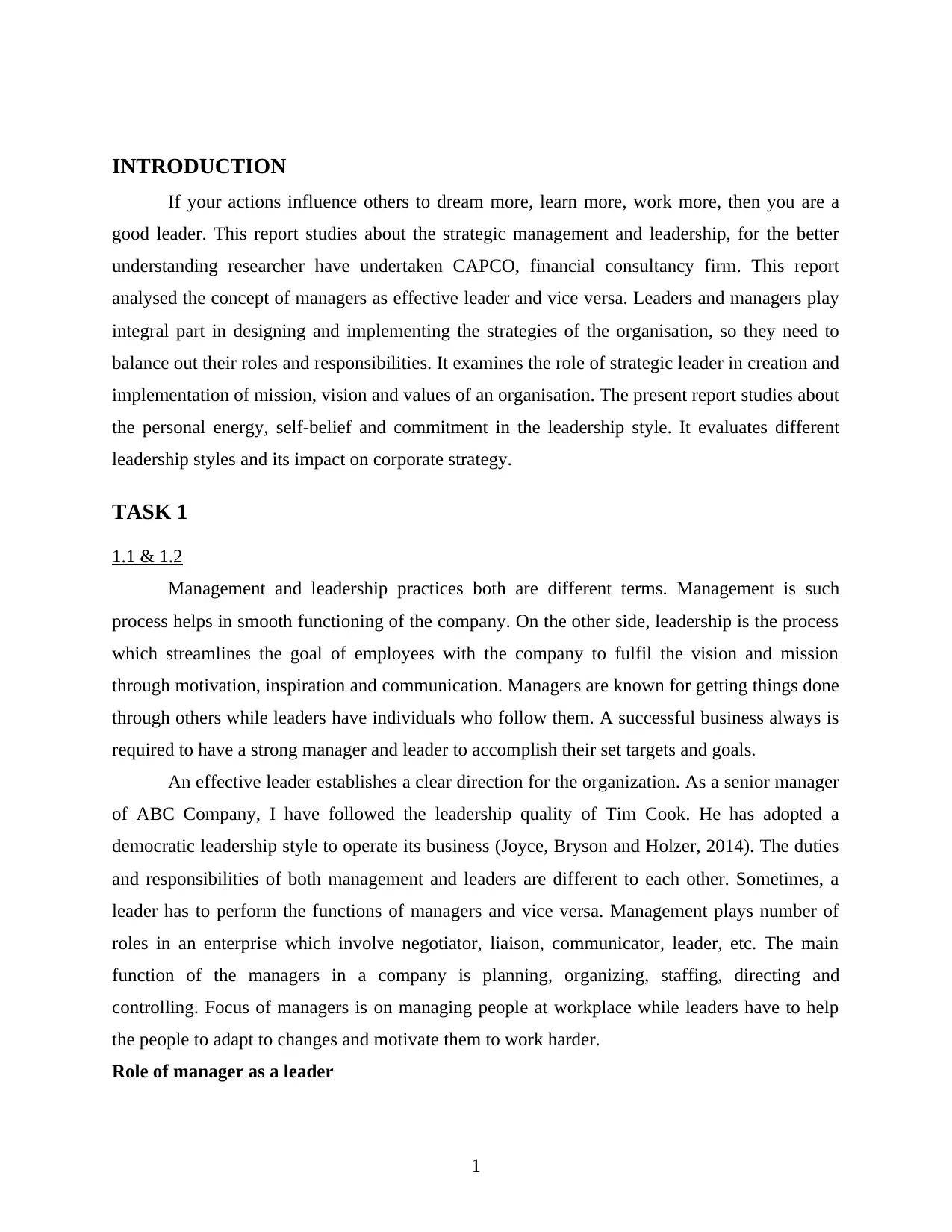
INTRODUCTION
If your actions influence others to dream more, learn more, work more, then you are a
good leader. This report studies about the strategic management and leadership, for the better
understanding researcher have undertaken CAPCO, financial consultancy firm. This report
analysed the concept of managers as effective leader and vice versa. Leaders and managers play
integral part in designing and implementing the strategies of the organisation, so they need to
balance out their roles and responsibilities. It examines the role of strategic leader in creation and
implementation of mission, vision and values of an organisation. The present report studies about
the personal energy, self-belief and commitment in the leadership style. It evaluates different
leadership styles and its impact on corporate strategy.
TASK 1
1.1 & 1.2
Management and leadership practices both are different terms. Management is such
process helps in smooth functioning of the company. On the other side, leadership is the process
which streamlines the goal of employees with the company to fulfil the vision and mission
through motivation, inspiration and communication. Managers are known for getting things done
through others while leaders have individuals who follow them. A successful business always is
required to have a strong manager and leader to accomplish their set targets and goals.
An effective leader establishes a clear direction for the organization. As a senior manager
of ABC Company, I have followed the leadership quality of Tim Cook. He has adopted a
democratic leadership style to operate its business (Joyce, Bryson and Holzer, 2014). The duties
and responsibilities of both management and leaders are different to each other. Sometimes, a
leader has to perform the functions of managers and vice versa. Management plays number of
roles in an enterprise which involve negotiator, liaison, communicator, leader, etc. The main
function of the managers in a company is planning, organizing, staffing, directing and
controlling. Focus of managers is on managing people at workplace while leaders have to help
the people to adapt to changes and motivate them to work harder.
Role of manager as a leader
1
If your actions influence others to dream more, learn more, work more, then you are a
good leader. This report studies about the strategic management and leadership, for the better
understanding researcher have undertaken CAPCO, financial consultancy firm. This report
analysed the concept of managers as effective leader and vice versa. Leaders and managers play
integral part in designing and implementing the strategies of the organisation, so they need to
balance out their roles and responsibilities. It examines the role of strategic leader in creation and
implementation of mission, vision and values of an organisation. The present report studies about
the personal energy, self-belief and commitment in the leadership style. It evaluates different
leadership styles and its impact on corporate strategy.
TASK 1
1.1 & 1.2
Management and leadership practices both are different terms. Management is such
process helps in smooth functioning of the company. On the other side, leadership is the process
which streamlines the goal of employees with the company to fulfil the vision and mission
through motivation, inspiration and communication. Managers are known for getting things done
through others while leaders have individuals who follow them. A successful business always is
required to have a strong manager and leader to accomplish their set targets and goals.
An effective leader establishes a clear direction for the organization. As a senior manager
of ABC Company, I have followed the leadership quality of Tim Cook. He has adopted a
democratic leadership style to operate its business (Joyce, Bryson and Holzer, 2014). The duties
and responsibilities of both management and leaders are different to each other. Sometimes, a
leader has to perform the functions of managers and vice versa. Management plays number of
roles in an enterprise which involve negotiator, liaison, communicator, leader, etc. The main
function of the managers in a company is planning, organizing, staffing, directing and
controlling. Focus of managers is on managing people at workplace while leaders have to help
the people to adapt to changes and motivate them to work harder.
Role of manager as a leader
1
⊘ This is a preview!⊘
Do you want full access?
Subscribe today to unlock all pages.

Trusted by 1+ million students worldwide
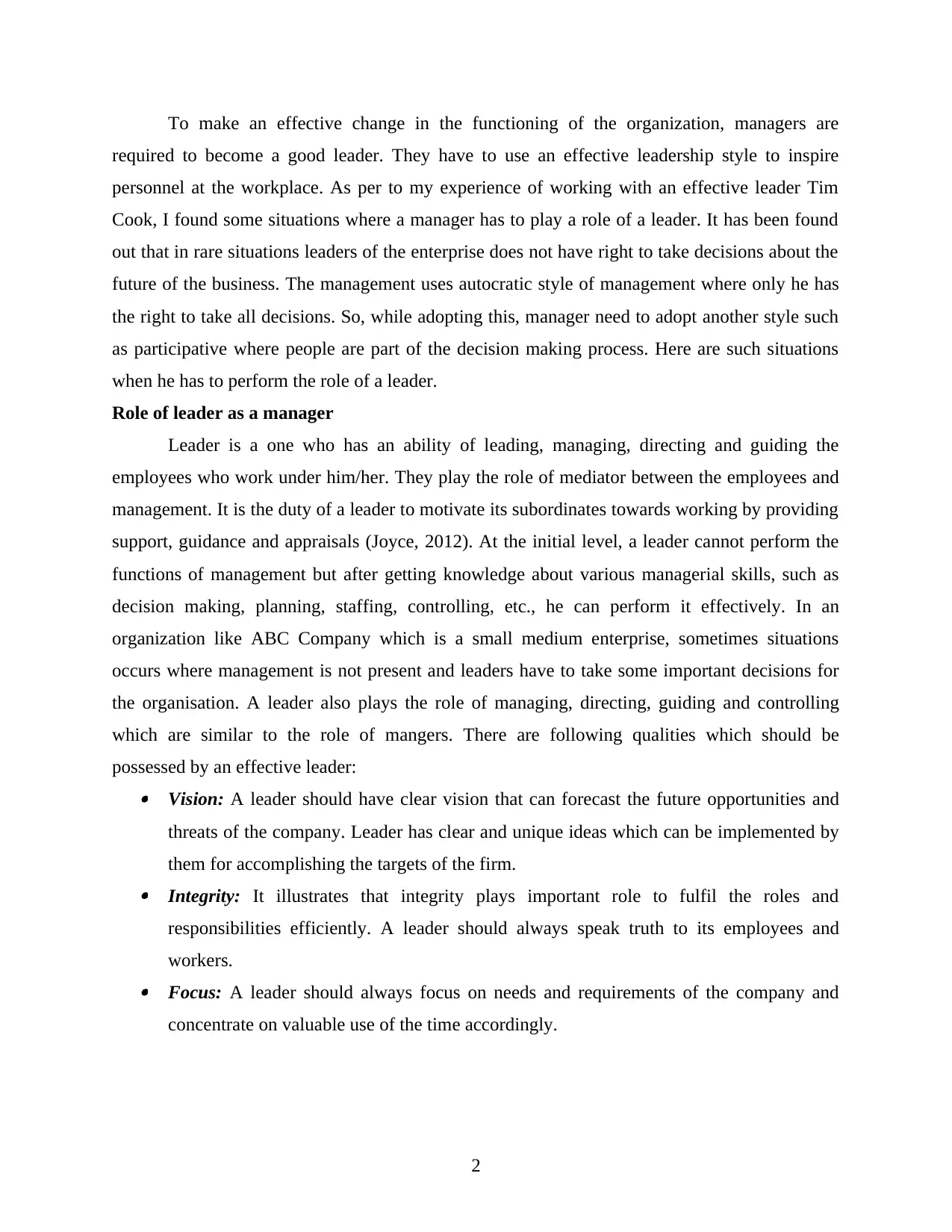
To make an effective change in the functioning of the organization, managers are
required to become a good leader. They have to use an effective leadership style to inspire
personnel at the workplace. As per to my experience of working with an effective leader Tim
Cook, I found some situations where a manager has to play a role of a leader. It has been found
out that in rare situations leaders of the enterprise does not have right to take decisions about the
future of the business. The management uses autocratic style of management where only he has
the right to take all decisions. So, while adopting this, manager need to adopt another style such
as participative where people are part of the decision making process. Here are such situations
when he has to perform the role of a leader.
Role of leader as a manager
Leader is a one who has an ability of leading, managing, directing and guiding the
employees who work under him/her. They play the role of mediator between the employees and
management. It is the duty of a leader to motivate its subordinates towards working by providing
support, guidance and appraisals (Joyce, 2012). At the initial level, a leader cannot perform the
functions of management but after getting knowledge about various managerial skills, such as
decision making, planning, staffing, controlling, etc., he can perform it effectively. In an
organization like ABC Company which is a small medium enterprise, sometimes situations
occurs where management is not present and leaders have to take some important decisions for
the organisation. A leader also plays the role of managing, directing, guiding and controlling
which are similar to the role of mangers. There are following qualities which should be
possessed by an effective leader: Vision: A leader should have clear vision that can forecast the future opportunities and
threats of the company. Leader has clear and unique ideas which can be implemented by
them for accomplishing the targets of the firm. Integrity: It illustrates that integrity plays important role to fulfil the roles and
responsibilities efficiently. A leader should always speak truth to its employees and
workers. Focus: A leader should always focus on needs and requirements of the company and
concentrate on valuable use of the time accordingly.
2
required to become a good leader. They have to use an effective leadership style to inspire
personnel at the workplace. As per to my experience of working with an effective leader Tim
Cook, I found some situations where a manager has to play a role of a leader. It has been found
out that in rare situations leaders of the enterprise does not have right to take decisions about the
future of the business. The management uses autocratic style of management where only he has
the right to take all decisions. So, while adopting this, manager need to adopt another style such
as participative where people are part of the decision making process. Here are such situations
when he has to perform the role of a leader.
Role of leader as a manager
Leader is a one who has an ability of leading, managing, directing and guiding the
employees who work under him/her. They play the role of mediator between the employees and
management. It is the duty of a leader to motivate its subordinates towards working by providing
support, guidance and appraisals (Joyce, 2012). At the initial level, a leader cannot perform the
functions of management but after getting knowledge about various managerial skills, such as
decision making, planning, staffing, controlling, etc., he can perform it effectively. In an
organization like ABC Company which is a small medium enterprise, sometimes situations
occurs where management is not present and leaders have to take some important decisions for
the organisation. A leader also plays the role of managing, directing, guiding and controlling
which are similar to the role of mangers. There are following qualities which should be
possessed by an effective leader: Vision: A leader should have clear vision that can forecast the future opportunities and
threats of the company. Leader has clear and unique ideas which can be implemented by
them for accomplishing the targets of the firm. Integrity: It illustrates that integrity plays important role to fulfil the roles and
responsibilities efficiently. A leader should always speak truth to its employees and
workers. Focus: A leader should always focus on needs and requirements of the company and
concentrate on valuable use of the time accordingly.
2
Paraphrase This Document
Need a fresh take? Get an instant paraphrase of this document with our AI Paraphraser
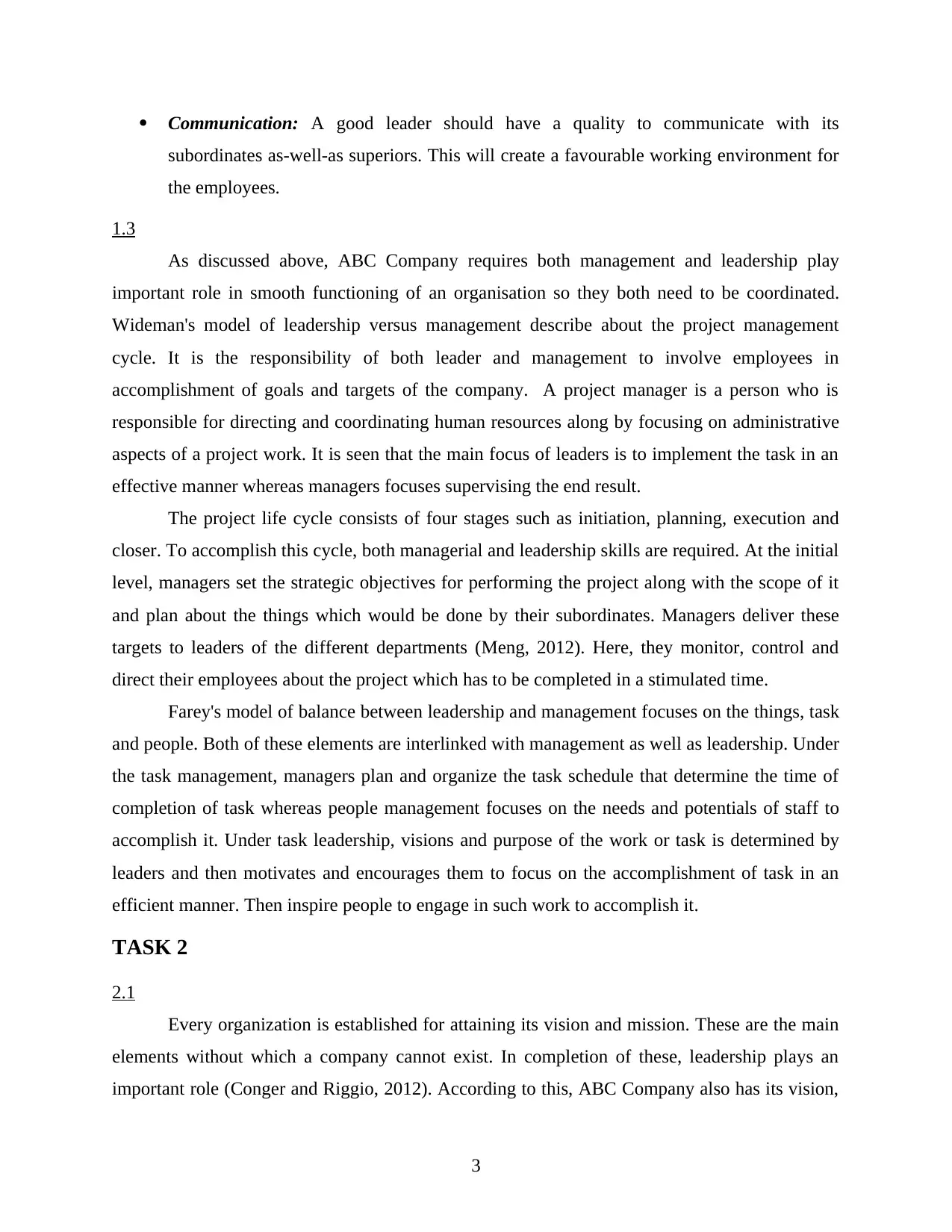
Communication: A good leader should have a quality to communicate with its
subordinates as-well-as superiors. This will create a favourable working environment for
the employees.
1.3
As discussed above, ABC Company requires both management and leadership play
important role in smooth functioning of an organisation so they both need to be coordinated.
Wideman's model of leadership versus management describe about the project management
cycle. It is the responsibility of both leader and management to involve employees in
accomplishment of goals and targets of the company. A project manager is a person who is
responsible for directing and coordinating human resources along by focusing on administrative
aspects of a project work. It is seen that the main focus of leaders is to implement the task in an
effective manner whereas managers focuses supervising the end result.
The project life cycle consists of four stages such as initiation, planning, execution and
closer. To accomplish this cycle, both managerial and leadership skills are required. At the initial
level, managers set the strategic objectives for performing the project along with the scope of it
and plan about the things which would be done by their subordinates. Managers deliver these
targets to leaders of the different departments (Meng, 2012). Here, they monitor, control and
direct their employees about the project which has to be completed in a stimulated time.
Farey's model of balance between leadership and management focuses on the things, task
and people. Both of these elements are interlinked with management as well as leadership. Under
the task management, managers plan and organize the task schedule that determine the time of
completion of task whereas people management focuses on the needs and potentials of staff to
accomplish it. Under task leadership, visions and purpose of the work or task is determined by
leaders and then motivates and encourages them to focus on the accomplishment of task in an
efficient manner. Then inspire people to engage in such work to accomplish it.
TASK 2
2.1
Every organization is established for attaining its vision and mission. These are the main
elements without which a company cannot exist. In completion of these, leadership plays an
important role (Conger and Riggio, 2012). According to this, ABC Company also has its vision,
3
subordinates as-well-as superiors. This will create a favourable working environment for
the employees.
1.3
As discussed above, ABC Company requires both management and leadership play
important role in smooth functioning of an organisation so they both need to be coordinated.
Wideman's model of leadership versus management describe about the project management
cycle. It is the responsibility of both leader and management to involve employees in
accomplishment of goals and targets of the company. A project manager is a person who is
responsible for directing and coordinating human resources along by focusing on administrative
aspects of a project work. It is seen that the main focus of leaders is to implement the task in an
effective manner whereas managers focuses supervising the end result.
The project life cycle consists of four stages such as initiation, planning, execution and
closer. To accomplish this cycle, both managerial and leadership skills are required. At the initial
level, managers set the strategic objectives for performing the project along with the scope of it
and plan about the things which would be done by their subordinates. Managers deliver these
targets to leaders of the different departments (Meng, 2012). Here, they monitor, control and
direct their employees about the project which has to be completed in a stimulated time.
Farey's model of balance between leadership and management focuses on the things, task
and people. Both of these elements are interlinked with management as well as leadership. Under
the task management, managers plan and organize the task schedule that determine the time of
completion of task whereas people management focuses on the needs and potentials of staff to
accomplish it. Under task leadership, visions and purpose of the work or task is determined by
leaders and then motivates and encourages them to focus on the accomplishment of task in an
efficient manner. Then inspire people to engage in such work to accomplish it.
TASK 2
2.1
Every organization is established for attaining its vision and mission. These are the main
elements without which a company cannot exist. In completion of these, leadership plays an
important role (Conger and Riggio, 2012). According to this, ABC Company also has its vision,
3
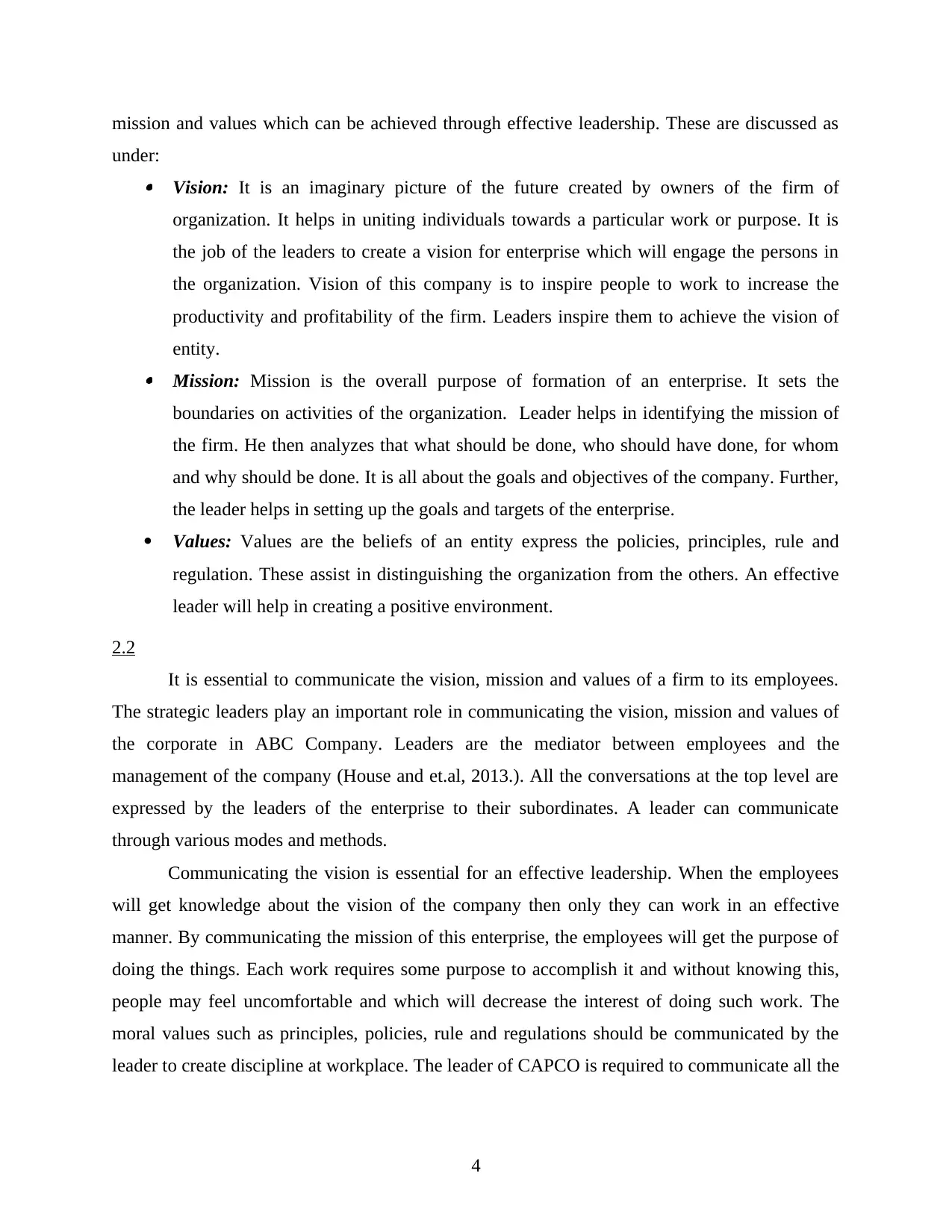
mission and values which can be achieved through effective leadership. These are discussed as
under: Vision: It is an imaginary picture of the future created by owners of the firm of
organization. It helps in uniting individuals towards a particular work or purpose. It is
the job of the leaders to create a vision for enterprise which will engage the persons in
the organization. Vision of this company is to inspire people to work to increase the
productivity and profitability of the firm. Leaders inspire them to achieve the vision of
entity. Mission: Mission is the overall purpose of formation of an enterprise. It sets the
boundaries on activities of the organization. Leader helps in identifying the mission of
the firm. He then analyzes that what should be done, who should have done, for whom
and why should be done. It is all about the goals and objectives of the company. Further,
the leader helps in setting up the goals and targets of the enterprise.
Values: Values are the beliefs of an entity express the policies, principles, rule and
regulation. These assist in distinguishing the organization from the others. An effective
leader will help in creating a positive environment.
2.2
It is essential to communicate the vision, mission and values of a firm to its employees.
The strategic leaders play an important role in communicating the vision, mission and values of
the corporate in ABC Company. Leaders are the mediator between employees and the
management of the company (House and et.al, 2013.). All the conversations at the top level are
expressed by the leaders of the enterprise to their subordinates. A leader can communicate
through various modes and methods.
Communicating the vision is essential for an effective leadership. When the employees
will get knowledge about the vision of the company then only they can work in an effective
manner. By communicating the mission of this enterprise, the employees will get the purpose of
doing the things. Each work requires some purpose to accomplish it and without knowing this,
people may feel uncomfortable and which will decrease the interest of doing such work. The
moral values such as principles, policies, rule and regulations should be communicated by the
leader to create discipline at workplace. The leader of CAPCO is required to communicate all the
4
under: Vision: It is an imaginary picture of the future created by owners of the firm of
organization. It helps in uniting individuals towards a particular work or purpose. It is
the job of the leaders to create a vision for enterprise which will engage the persons in
the organization. Vision of this company is to inspire people to work to increase the
productivity and profitability of the firm. Leaders inspire them to achieve the vision of
entity. Mission: Mission is the overall purpose of formation of an enterprise. It sets the
boundaries on activities of the organization. Leader helps in identifying the mission of
the firm. He then analyzes that what should be done, who should have done, for whom
and why should be done. It is all about the goals and objectives of the company. Further,
the leader helps in setting up the goals and targets of the enterprise.
Values: Values are the beliefs of an entity express the policies, principles, rule and
regulation. These assist in distinguishing the organization from the others. An effective
leader will help in creating a positive environment.
2.2
It is essential to communicate the vision, mission and values of a firm to its employees.
The strategic leaders play an important role in communicating the vision, mission and values of
the corporate in ABC Company. Leaders are the mediator between employees and the
management of the company (House and et.al, 2013.). All the conversations at the top level are
expressed by the leaders of the enterprise to their subordinates. A leader can communicate
through various modes and methods.
Communicating the vision is essential for an effective leadership. When the employees
will get knowledge about the vision of the company then only they can work in an effective
manner. By communicating the mission of this enterprise, the employees will get the purpose of
doing the things. Each work requires some purpose to accomplish it and without knowing this,
people may feel uncomfortable and which will decrease the interest of doing such work. The
moral values such as principles, policies, rule and regulations should be communicated by the
leader to create discipline at workplace. The leader of CAPCO is required to communicate all the
4
⊘ This is a preview!⊘
Do you want full access?
Subscribe today to unlock all pages.

Trusted by 1+ million students worldwide
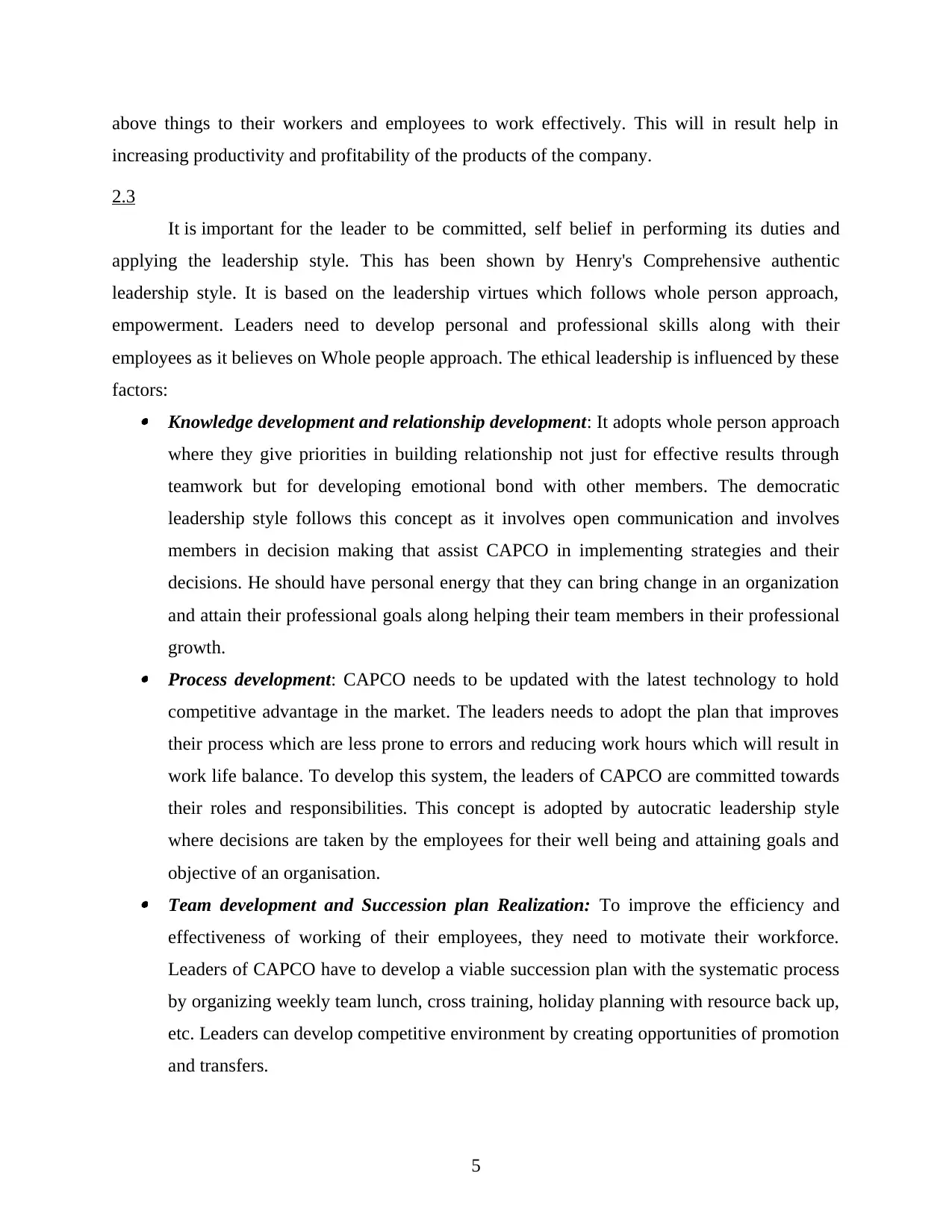
above things to their workers and employees to work effectively. This will in result help in
increasing productivity and profitability of the products of the company.
2.3
It is important for the leader to be committed, self belief in performing its duties and
applying the leadership style. This has been shown by Henry's Comprehensive authentic
leadership style. It is based on the leadership virtues which follows whole person approach,
empowerment. Leaders need to develop personal and professional skills along with their
employees as it believes on Whole people approach. The ethical leadership is influenced by these
factors: Knowledge development and relationship development: It adopts whole person approach
where they give priorities in building relationship not just for effective results through
teamwork but for developing emotional bond with other members. The democratic
leadership style follows this concept as it involves open communication and involves
members in decision making that assist CAPCO in implementing strategies and their
decisions. He should have personal energy that they can bring change in an organization
and attain their professional goals along helping their team members in their professional
growth. Process development: CAPCO needs to be updated with the latest technology to hold
competitive advantage in the market. The leaders needs to adopt the plan that improves
their process which are less prone to errors and reducing work hours which will result in
work life balance. To develop this system, the leaders of CAPCO are committed towards
their roles and responsibilities. This concept is adopted by autocratic leadership style
where decisions are taken by the employees for their well being and attaining goals and
objective of an organisation. Team development and Succession plan Realization: To improve the efficiency and
effectiveness of working of their employees, they need to motivate their workforce.
Leaders of CAPCO have to develop a viable succession plan with the systematic process
by organizing weekly team lunch, cross training, holiday planning with resource back up,
etc. Leaders can develop competitive environment by creating opportunities of promotion
and transfers.
5
increasing productivity and profitability of the products of the company.
2.3
It is important for the leader to be committed, self belief in performing its duties and
applying the leadership style. This has been shown by Henry's Comprehensive authentic
leadership style. It is based on the leadership virtues which follows whole person approach,
empowerment. Leaders need to develop personal and professional skills along with their
employees as it believes on Whole people approach. The ethical leadership is influenced by these
factors: Knowledge development and relationship development: It adopts whole person approach
where they give priorities in building relationship not just for effective results through
teamwork but for developing emotional bond with other members. The democratic
leadership style follows this concept as it involves open communication and involves
members in decision making that assist CAPCO in implementing strategies and their
decisions. He should have personal energy that they can bring change in an organization
and attain their professional goals along helping their team members in their professional
growth. Process development: CAPCO needs to be updated with the latest technology to hold
competitive advantage in the market. The leaders needs to adopt the plan that improves
their process which are less prone to errors and reducing work hours which will result in
work life balance. To develop this system, the leaders of CAPCO are committed towards
their roles and responsibilities. This concept is adopted by autocratic leadership style
where decisions are taken by the employees for their well being and attaining goals and
objective of an organisation. Team development and Succession plan Realization: To improve the efficiency and
effectiveness of working of their employees, they need to motivate their workforce.
Leaders of CAPCO have to develop a viable succession plan with the systematic process
by organizing weekly team lunch, cross training, holiday planning with resource back up,
etc. Leaders can develop competitive environment by creating opportunities of promotion
and transfers.
5
Paraphrase This Document
Need a fresh take? Get an instant paraphrase of this document with our AI Paraphraser
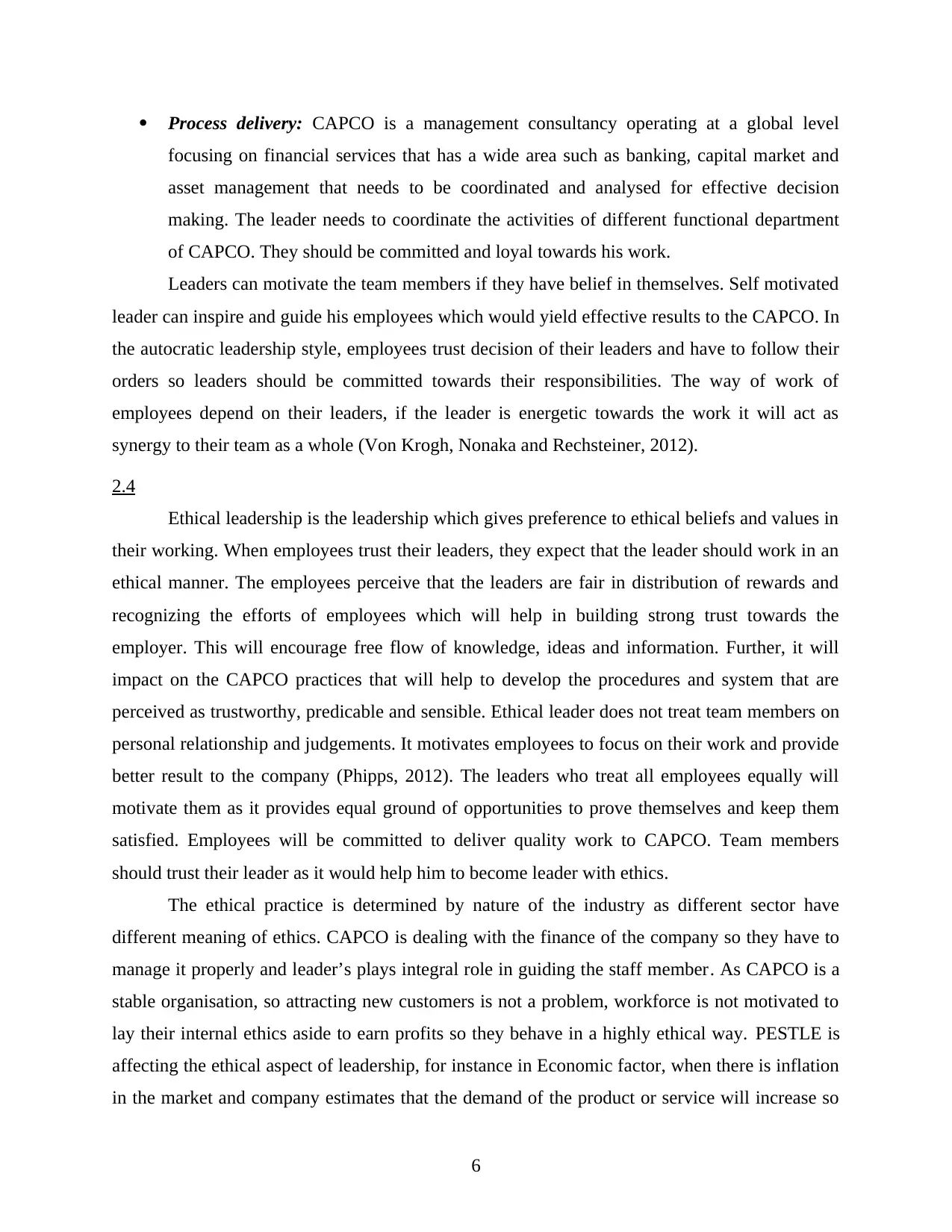
Process delivery: CAPCO is a management consultancy operating at a global level
focusing on financial services that has a wide area such as banking, capital market and
asset management that needs to be coordinated and analysed for effective decision
making. The leader needs to coordinate the activities of different functional department
of CAPCO. They should be committed and loyal towards his work.
Leaders can motivate the team members if they have belief in themselves. Self motivated
leader can inspire and guide his employees which would yield effective results to the CAPCO. In
the autocratic leadership style, employees trust decision of their leaders and have to follow their
orders so leaders should be committed towards their responsibilities. The way of work of
employees depend on their leaders, if the leader is energetic towards the work it will act as
synergy to their team as a whole (Von Krogh, Nonaka and Rechsteiner, 2012).
2.4
Ethical leadership is the leadership which gives preference to ethical beliefs and values in
their working. When employees trust their leaders, they expect that the leader should work in an
ethical manner. The employees perceive that the leaders are fair in distribution of rewards and
recognizing the efforts of employees which will help in building strong trust towards the
employer. This will encourage free flow of knowledge, ideas and information. Further, it will
impact on the CAPCO practices that will help to develop the procedures and system that are
perceived as trustworthy, predicable and sensible. Ethical leader does not treat team members on
personal relationship and judgements. It motivates employees to focus on their work and provide
better result to the company (Phipps, 2012). The leaders who treat all employees equally will
motivate them as it provides equal ground of opportunities to prove themselves and keep them
satisfied. Employees will be committed to deliver quality work to CAPCO. Team members
should trust their leader as it would help him to become leader with ethics.
The ethical practice is determined by nature of the industry as different sector have
different meaning of ethics. CAPCO is dealing with the finance of the company so they have to
manage it properly and leader’s plays integral role in guiding the staff member. As CAPCO is a
stable organisation, so attracting new customers is not a problem, workforce is not motivated to
lay their internal ethics aside to earn profits so they behave in a highly ethical way. PESTLE is
affecting the ethical aspect of leadership, for instance in Economic factor, when there is inflation
in the market and company estimates that the demand of the product or service will increase so
6
focusing on financial services that has a wide area such as banking, capital market and
asset management that needs to be coordinated and analysed for effective decision
making. The leader needs to coordinate the activities of different functional department
of CAPCO. They should be committed and loyal towards his work.
Leaders can motivate the team members if they have belief in themselves. Self motivated
leader can inspire and guide his employees which would yield effective results to the CAPCO. In
the autocratic leadership style, employees trust decision of their leaders and have to follow their
orders so leaders should be committed towards their responsibilities. The way of work of
employees depend on their leaders, if the leader is energetic towards the work it will act as
synergy to their team as a whole (Von Krogh, Nonaka and Rechsteiner, 2012).
2.4
Ethical leadership is the leadership which gives preference to ethical beliefs and values in
their working. When employees trust their leaders, they expect that the leader should work in an
ethical manner. The employees perceive that the leaders are fair in distribution of rewards and
recognizing the efforts of employees which will help in building strong trust towards the
employer. This will encourage free flow of knowledge, ideas and information. Further, it will
impact on the CAPCO practices that will help to develop the procedures and system that are
perceived as trustworthy, predicable and sensible. Ethical leader does not treat team members on
personal relationship and judgements. It motivates employees to focus on their work and provide
better result to the company (Phipps, 2012). The leaders who treat all employees equally will
motivate them as it provides equal ground of opportunities to prove themselves and keep them
satisfied. Employees will be committed to deliver quality work to CAPCO. Team members
should trust their leader as it would help him to become leader with ethics.
The ethical practice is determined by nature of the industry as different sector have
different meaning of ethics. CAPCO is dealing with the finance of the company so they have to
manage it properly and leader’s plays integral role in guiding the staff member. As CAPCO is a
stable organisation, so attracting new customers is not a problem, workforce is not motivated to
lay their internal ethics aside to earn profits so they behave in a highly ethical way. PESTLE is
affecting the ethical aspect of leadership, for instance in Economic factor, when there is inflation
in the market and company estimates that the demand of the product or service will increase so
6
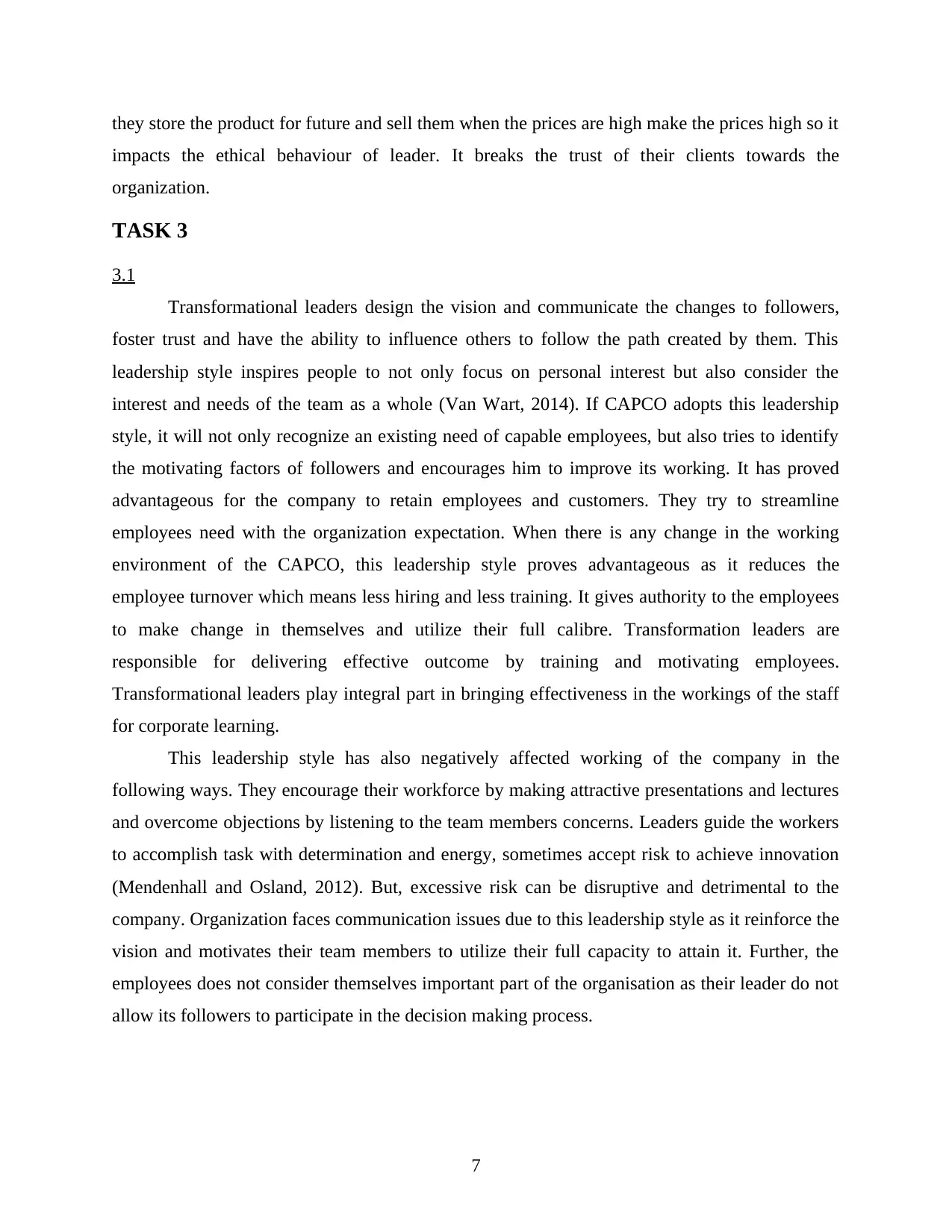
they store the product for future and sell them when the prices are high make the prices high so it
impacts the ethical behaviour of leader. It breaks the trust of their clients towards the
organization.
TASK 3
3.1
Transformational leaders design the vision and communicate the changes to followers,
foster trust and have the ability to influence others to follow the path created by them. This
leadership style inspires people to not only focus on personal interest but also consider the
interest and needs of the team as a whole (Van Wart, 2014). If CAPCO adopts this leadership
style, it will not only recognize an existing need of capable employees, but also tries to identify
the motivating factors of followers and encourages him to improve its working. It has proved
advantageous for the company to retain employees and customers. They try to streamline
employees need with the organization expectation. When there is any change in the working
environment of the CAPCO, this leadership style proves advantageous as it reduces the
employee turnover which means less hiring and less training. It gives authority to the employees
to make change in themselves and utilize their full calibre. Transformation leaders are
responsible for delivering effective outcome by training and motivating employees.
Transformational leaders play integral part in bringing effectiveness in the workings of the staff
for corporate learning.
This leadership style has also negatively affected working of the company in the
following ways. They encourage their workforce by making attractive presentations and lectures
and overcome objections by listening to the team members concerns. Leaders guide the workers
to accomplish task with determination and energy, sometimes accept risk to achieve innovation
(Mendenhall and Osland, 2012). But, excessive risk can be disruptive and detrimental to the
company. Organization faces communication issues due to this leadership style as it reinforce the
vision and motivates their team members to utilize their full capacity to attain it. Further, the
employees does not consider themselves important part of the organisation as their leader do not
allow its followers to participate in the decision making process.
7
impacts the ethical behaviour of leader. It breaks the trust of their clients towards the
organization.
TASK 3
3.1
Transformational leaders design the vision and communicate the changes to followers,
foster trust and have the ability to influence others to follow the path created by them. This
leadership style inspires people to not only focus on personal interest but also consider the
interest and needs of the team as a whole (Van Wart, 2014). If CAPCO adopts this leadership
style, it will not only recognize an existing need of capable employees, but also tries to identify
the motivating factors of followers and encourages him to improve its working. It has proved
advantageous for the company to retain employees and customers. They try to streamline
employees need with the organization expectation. When there is any change in the working
environment of the CAPCO, this leadership style proves advantageous as it reduces the
employee turnover which means less hiring and less training. It gives authority to the employees
to make change in themselves and utilize their full calibre. Transformation leaders are
responsible for delivering effective outcome by training and motivating employees.
Transformational leaders play integral part in bringing effectiveness in the workings of the staff
for corporate learning.
This leadership style has also negatively affected working of the company in the
following ways. They encourage their workforce by making attractive presentations and lectures
and overcome objections by listening to the team members concerns. Leaders guide the workers
to accomplish task with determination and energy, sometimes accept risk to achieve innovation
(Mendenhall and Osland, 2012). But, excessive risk can be disruptive and detrimental to the
company. Organization faces communication issues due to this leadership style as it reinforce the
vision and motivates their team members to utilize their full capacity to attain it. Further, the
employees does not consider themselves important part of the organisation as their leader do not
allow its followers to participate in the decision making process.
7
⊘ This is a preview!⊘
Do you want full access?
Subscribe today to unlock all pages.

Trusted by 1+ million students worldwide
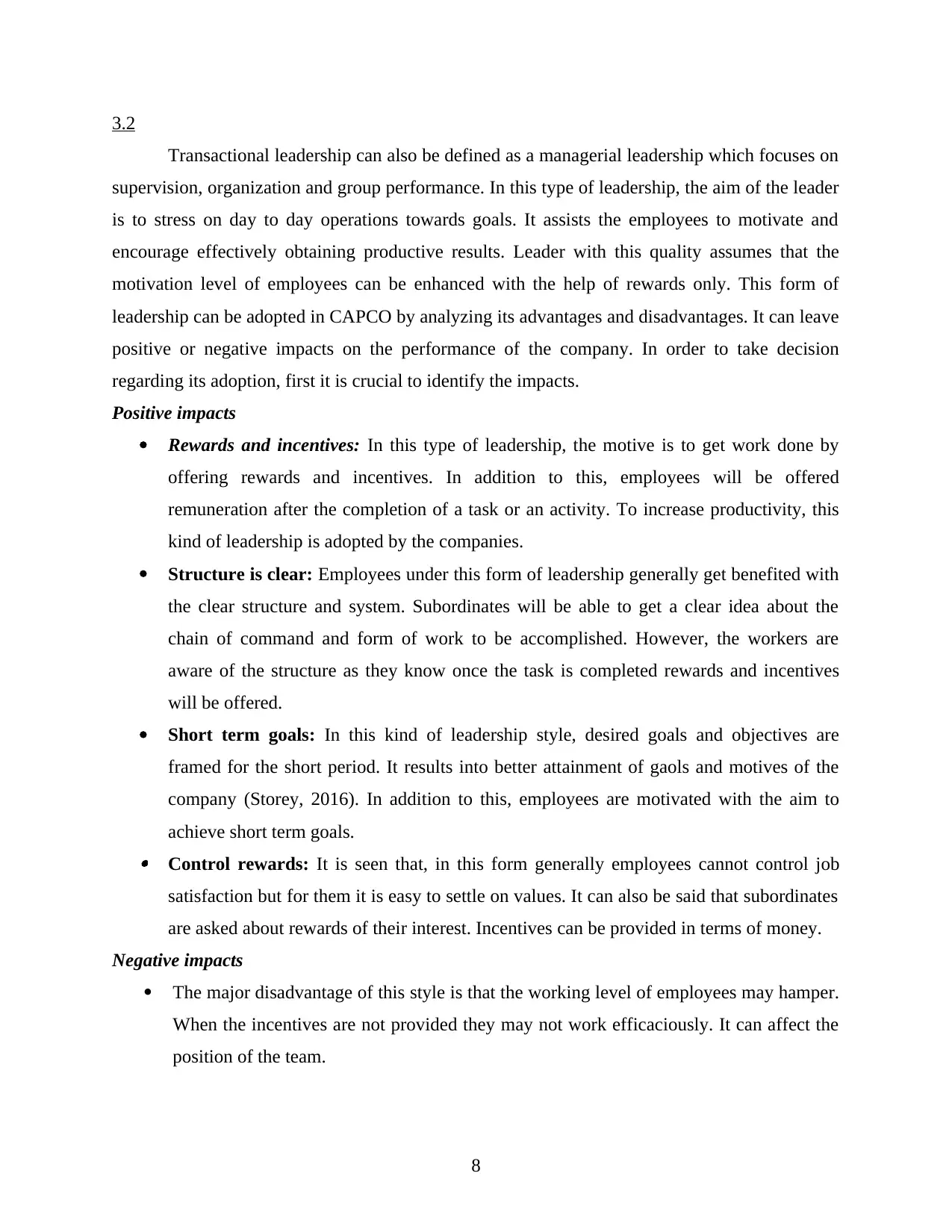
3.2
Transactional leadership can also be defined as a managerial leadership which focuses on
supervision, organization and group performance. In this type of leadership, the aim of the leader
is to stress on day to day operations towards goals. It assists the employees to motivate and
encourage effectively obtaining productive results. Leader with this quality assumes that the
motivation level of employees can be enhanced with the help of rewards only. This form of
leadership can be adopted in CAPCO by analyzing its advantages and disadvantages. It can leave
positive or negative impacts on the performance of the company. In order to take decision
regarding its adoption, first it is crucial to identify the impacts.
Positive impacts
Rewards and incentives: In this type of leadership, the motive is to get work done by
offering rewards and incentives. In addition to this, employees will be offered
remuneration after the completion of a task or an activity. To increase productivity, this
kind of leadership is adopted by the companies.
Structure is clear: Employees under this form of leadership generally get benefited with
the clear structure and system. Subordinates will be able to get a clear idea about the
chain of command and form of work to be accomplished. However, the workers are
aware of the structure as they know once the task is completed rewards and incentives
will be offered.
Short term goals: In this kind of leadership style, desired goals and objectives are
framed for the short period. It results into better attainment of gaols and motives of the
company (Storey, 2016). In addition to this, employees are motivated with the aim to
achieve short term goals. Control rewards: It is seen that, in this form generally employees cannot control job
satisfaction but for them it is easy to settle on values. It can also be said that subordinates
are asked about rewards of their interest. Incentives can be provided in terms of money.
Negative impacts
The major disadvantage of this style is that the working level of employees may hamper.
When the incentives are not provided they may not work efficaciously. It can affect the
position of the team.
8
Transactional leadership can also be defined as a managerial leadership which focuses on
supervision, organization and group performance. In this type of leadership, the aim of the leader
is to stress on day to day operations towards goals. It assists the employees to motivate and
encourage effectively obtaining productive results. Leader with this quality assumes that the
motivation level of employees can be enhanced with the help of rewards only. This form of
leadership can be adopted in CAPCO by analyzing its advantages and disadvantages. It can leave
positive or negative impacts on the performance of the company. In order to take decision
regarding its adoption, first it is crucial to identify the impacts.
Positive impacts
Rewards and incentives: In this type of leadership, the motive is to get work done by
offering rewards and incentives. In addition to this, employees will be offered
remuneration after the completion of a task or an activity. To increase productivity, this
kind of leadership is adopted by the companies.
Structure is clear: Employees under this form of leadership generally get benefited with
the clear structure and system. Subordinates will be able to get a clear idea about the
chain of command and form of work to be accomplished. However, the workers are
aware of the structure as they know once the task is completed rewards and incentives
will be offered.
Short term goals: In this kind of leadership style, desired goals and objectives are
framed for the short period. It results into better attainment of gaols and motives of the
company (Storey, 2016). In addition to this, employees are motivated with the aim to
achieve short term goals. Control rewards: It is seen that, in this form generally employees cannot control job
satisfaction but for them it is easy to settle on values. It can also be said that subordinates
are asked about rewards of their interest. Incentives can be provided in terms of money.
Negative impacts
The major disadvantage of this style is that the working level of employees may hamper.
When the incentives are not provided they may not work efficaciously. It can affect the
position of the team.
8
Paraphrase This Document
Need a fresh take? Get an instant paraphrase of this document with our AI Paraphraser
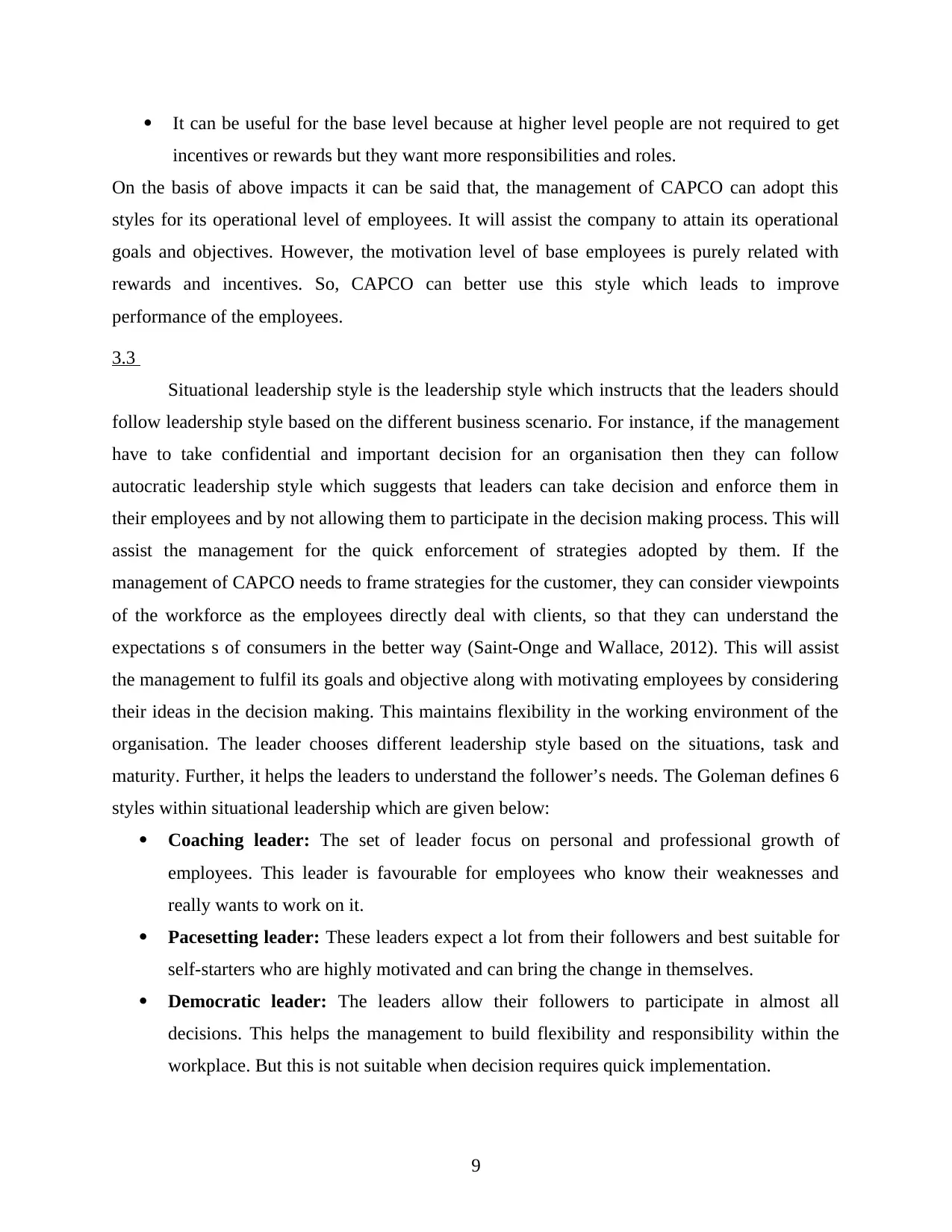
It can be useful for the base level because at higher level people are not required to get
incentives or rewards but they want more responsibilities and roles.
On the basis of above impacts it can be said that, the management of CAPCO can adopt this
styles for its operational level of employees. It will assist the company to attain its operational
goals and objectives. However, the motivation level of base employees is purely related with
rewards and incentives. So, CAPCO can better use this style which leads to improve
performance of the employees.
3.3
Situational leadership style is the leadership style which instructs that the leaders should
follow leadership style based on the different business scenario. For instance, if the management
have to take confidential and important decision for an organisation then they can follow
autocratic leadership style which suggests that leaders can take decision and enforce them in
their employees and by not allowing them to participate in the decision making process. This will
assist the management for the quick enforcement of strategies adopted by them. If the
management of CAPCO needs to frame strategies for the customer, they can consider viewpoints
of the workforce as the employees directly deal with clients, so that they can understand the
expectations s of consumers in the better way (Saint-Onge and Wallace, 2012). This will assist
the management to fulfil its goals and objective along with motivating employees by considering
their ideas in the decision making. This maintains flexibility in the working environment of the
organisation. The leader chooses different leadership style based on the situations, task and
maturity. Further, it helps the leaders to understand the follower’s needs. The Goleman defines 6
styles within situational leadership which are given below:
Coaching leader: The set of leader focus on personal and professional growth of
employees. This leader is favourable for employees who know their weaknesses and
really wants to work on it.
Pacesetting leader: These leaders expect a lot from their followers and best suitable for
self-starters who are highly motivated and can bring the change in themselves.
Democratic leader: The leaders allow their followers to participate in almost all
decisions. This helps the management to build flexibility and responsibility within the
workplace. But this is not suitable when decision requires quick implementation.
9
incentives or rewards but they want more responsibilities and roles.
On the basis of above impacts it can be said that, the management of CAPCO can adopt this
styles for its operational level of employees. It will assist the company to attain its operational
goals and objectives. However, the motivation level of base employees is purely related with
rewards and incentives. So, CAPCO can better use this style which leads to improve
performance of the employees.
3.3
Situational leadership style is the leadership style which instructs that the leaders should
follow leadership style based on the different business scenario. For instance, if the management
have to take confidential and important decision for an organisation then they can follow
autocratic leadership style which suggests that leaders can take decision and enforce them in
their employees and by not allowing them to participate in the decision making process. This will
assist the management for the quick enforcement of strategies adopted by them. If the
management of CAPCO needs to frame strategies for the customer, they can consider viewpoints
of the workforce as the employees directly deal with clients, so that they can understand the
expectations s of consumers in the better way (Saint-Onge and Wallace, 2012). This will assist
the management to fulfil its goals and objective along with motivating employees by considering
their ideas in the decision making. This maintains flexibility in the working environment of the
organisation. The leader chooses different leadership style based on the situations, task and
maturity. Further, it helps the leaders to understand the follower’s needs. The Goleman defines 6
styles within situational leadership which are given below:
Coaching leader: The set of leader focus on personal and professional growth of
employees. This leader is favourable for employees who know their weaknesses and
really wants to work on it.
Pacesetting leader: These leaders expect a lot from their followers and best suitable for
self-starters who are highly motivated and can bring the change in themselves.
Democratic leader: The leaders allow their followers to participate in almost all
decisions. This helps the management to build flexibility and responsibility within the
workplace. But this is not suitable when decision requires quick implementation.
9
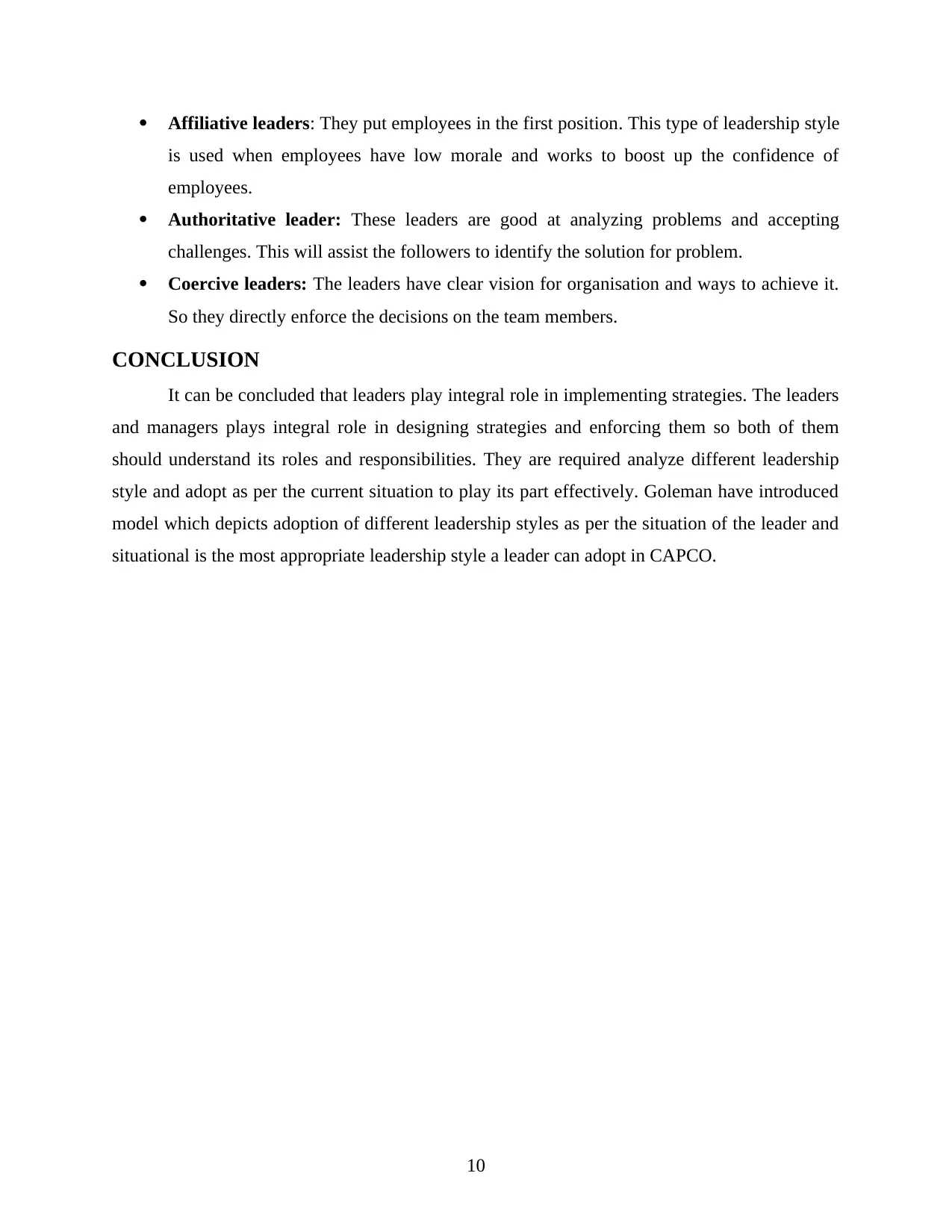
Affiliative leaders: They put employees in the first position. This type of leadership style
is used when employees have low morale and works to boost up the confidence of
employees.
Authoritative leader: These leaders are good at analyzing problems and accepting
challenges. This will assist the followers to identify the solution for problem.
Coercive leaders: The leaders have clear vision for organisation and ways to achieve it.
So they directly enforce the decisions on the team members.
CONCLUSION
It can be concluded that leaders play integral role in implementing strategies. The leaders
and managers plays integral role in designing strategies and enforcing them so both of them
should understand its roles and responsibilities. They are required analyze different leadership
style and adopt as per the current situation to play its part effectively. Goleman have introduced
model which depicts adoption of different leadership styles as per the situation of the leader and
situational is the most appropriate leadership style a leader can adopt in CAPCO.
10
is used when employees have low morale and works to boost up the confidence of
employees.
Authoritative leader: These leaders are good at analyzing problems and accepting
challenges. This will assist the followers to identify the solution for problem.
Coercive leaders: The leaders have clear vision for organisation and ways to achieve it.
So they directly enforce the decisions on the team members.
CONCLUSION
It can be concluded that leaders play integral role in implementing strategies. The leaders
and managers plays integral role in designing strategies and enforcing them so both of them
should understand its roles and responsibilities. They are required analyze different leadership
style and adopt as per the current situation to play its part effectively. Goleman have introduced
model which depicts adoption of different leadership styles as per the situation of the leader and
situational is the most appropriate leadership style a leader can adopt in CAPCO.
10
⊘ This is a preview!⊘
Do you want full access?
Subscribe today to unlock all pages.

Trusted by 1+ million students worldwide
1 out of 13
Related Documents
Your All-in-One AI-Powered Toolkit for Academic Success.
+13062052269
info@desklib.com
Available 24*7 on WhatsApp / Email
![[object Object]](/_next/static/media/star-bottom.7253800d.svg)
Unlock your academic potential
Copyright © 2020–2025 A2Z Services. All Rights Reserved. Developed and managed by ZUCOL.




